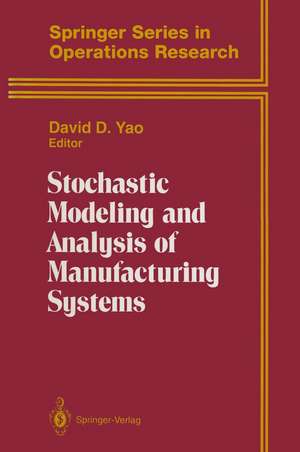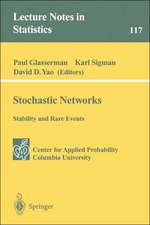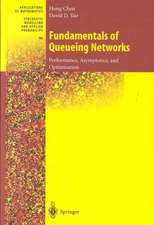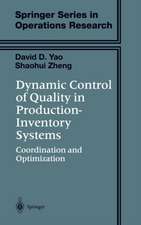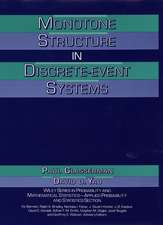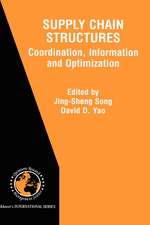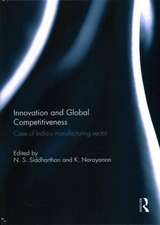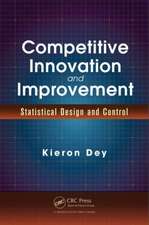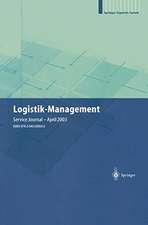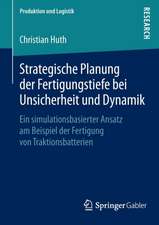Stochastic Modeling and Analysis of Manufacturing Systems: Springer Series in Operations Research and Financial Engineering
Editat de David D. Yaoen Limba Engleză Paperback – 12 aug 2013
The editor has invited a number of leading experts to present detailed expositions of specific topics. These include: Jackson networks, fluid models, diffusion and strong approximations, the GSMP framework, stochastic convexity and majorization, perturbation analysis, scheduling via Brownian models, and re-entrant lines and dynamic scheduling. Each chapter has been written with graduate students in mind, and several have been used in graduate courses that teach the modeling and analysis of manufacturing systems.
Din seria Springer Series in Operations Research and Financial Engineering
-
 Preț: 497.00 lei
Preț: 497.00 lei - 13%
 Preț: 355.75 lei
Preț: 355.75 lei - 15%
 Preț: 365.76 lei
Preț: 365.76 lei - 17%
 Preț: 503.67 lei
Preț: 503.67 lei - 17%
 Preț: 363.08 lei
Preț: 363.08 lei -
 Preț: 347.47 lei
Preț: 347.47 lei - 17%
 Preț: 370.05 lei
Preț: 370.05 lei - 13%
 Preț: 357.53 lei
Preț: 357.53 lei -
 Preț: 356.91 lei
Preț: 356.91 lei - 19%
 Preț: 575.59 lei
Preț: 575.59 lei - 18%
 Preț: 945.30 lei
Preț: 945.30 lei - 20%
 Preț: 639.28 lei
Preț: 639.28 lei - 23%
 Preț: 732.07 lei
Preț: 732.07 lei -
 Preț: 384.48 lei
Preț: 384.48 lei - 15%
 Preț: 638.43 lei
Preț: 638.43 lei - 18%
 Preț: 740.57 lei
Preț: 740.57 lei - 18%
 Preț: 1395.63 lei
Preț: 1395.63 lei -
 Preț: 407.98 lei
Preț: 407.98 lei -
 Preț: 358.39 lei
Preț: 358.39 lei - 20%
 Preț: 549.58 lei
Preț: 549.58 lei - 18%
 Preț: 737.43 lei
Preț: 737.43 lei - 15%
 Preț: 660.37 lei
Preț: 660.37 lei -
 Preț: 411.67 lei
Preț: 411.67 lei -
 Preț: 405.06 lei
Preț: 405.06 lei -
 Preț: 391.02 lei
Preț: 391.02 lei - 18%
 Preț: 898.13 lei
Preț: 898.13 lei -
 Preț: 495.84 lei
Preț: 495.84 lei - 19%
 Preț: 526.97 lei
Preț: 526.97 lei -
 Preț: 391.02 lei
Preț: 391.02 lei - 15%
 Preț: 538.61 lei
Preț: 538.61 lei - 15%
 Preț: 880.15 lei
Preț: 880.15 lei - 24%
 Preț: 831.85 lei
Preț: 831.85 lei - 18%
 Preț: 837.15 lei
Preț: 837.15 lei - 18%
 Preț: 801.65 lei
Preț: 801.65 lei - 15%
 Preț: 637.28 lei
Preț: 637.28 lei - 19%
 Preț: 529.48 lei
Preț: 529.48 lei -
 Preț: 391.42 lei
Preț: 391.42 lei
Preț: 392.97 lei
Nou
Puncte Express: 589
Preț estimativ în valută:
75.22€ • 81.73$ • 63.22£
75.22€ • 81.73$ • 63.22£
Carte tipărită la comandă
Livrare economică 21 aprilie-05 mai
Preluare comenzi: 021 569.72.76
Specificații
ISBN-13: 9781461276289
ISBN-10: 1461276284
Pagini: 380
Ilustrații: XV, 360 p. 7 illus. in color.
Dimensiuni: 155 x 235 x 20 mm
Greutate: 0.53 kg
Ediția:Softcover reprint of the original 1st ed. 1994
Editura: Springer
Colecția Springer
Seria Springer Series in Operations Research and Financial Engineering
Locul publicării:New York, NY, United States
ISBN-10: 1461276284
Pagini: 380
Ilustrații: XV, 360 p. 7 illus. in color.
Dimensiuni: 155 x 235 x 20 mm
Greutate: 0.53 kg
Ediția:Softcover reprint of the original 1st ed. 1994
Editura: Springer
Colecția Springer
Seria Springer Series in Operations Research and Financial Engineering
Locul publicării:New York, NY, United States
Public țintă
GraduateCuprins
1 Jackson Network Models of Manufacturing Systems.- 1.1 Introduction.- 1.2 Jackson Networks.- 1.3 The Throughput Function and Computation.- 1.4 Monotonicity of the Throughput Function.- 1.5 Concavity and Convexity.- 1.6 Multiple Servers.- 1.7 Resource Sharing.- 1.8 Arrangement and Majorization.- 1.9 Conclusions.- 1.10 Notes.- 1.11 References.- 2 Hierarchical Modeling of Stochastic Networks, Part I: Fluid Models.- 2.1 Introduction.- 2.2 A Flow Network in Discrete Time.- 2.3 Flow Networks in Continuous Time.- 2.4 Linear Fluid Network and Bottleneck Analysis.- 2.5 Functional Strong Law of Large Numbers.- 2.6 Applications and Hints at Prospects of Fluid Models.- 2.7 References and Comments.- 2.8 References.- 3 Hierarchical Modeling of Stochastic Networks, Part II: Strong Approximations.- 3.1 Introduction.- 3.2 The Model.- 3.3 Preliminaries.- 3.4 The Main Results.- 3.5 Fitting Parametes.- 3.6 Proof of the Main Results.- 3.7 References, Possible Extensions and Future Research.- 3.8 References.- 4 A GSMP Framework for the Analysis of Production Lines.- 4.1 Introduction.- 4.2 GSMP and Its Scheme.- 4.3 Structural Properties of the Scheme.- 4.4 The (a, 6, k) Tandem Queue.- 4.5 Properties with Respect to (a, b, k).- 4.6 Line Reversal.- 4.7 Subadditivity and Ergodicity.- 4.8 Cycle Time Limits.- 4.9 Notes.- 4.10 References.- 5 Stochastic Convexity and Stochastic Majorization.- 5.1 Introduction.- 5.2 Stochastic Order Relations: Functional Characterizations.- 5.3 Second-Order Stochastic Properties.- 5.4 Arrangement and Likelihood Ratio Orderings.- 5.5 Stochastic Rearrangement and Majorization.- 5.6 Notes.- 5.7 References.- 6 Perturbation Analysis of Production Networks.- 6.1 Introduction.- 6.2 Overview Through the Single-Machine Model.- 6.3 Differentiation.- 6.4 Analysis of the Single-Machine Model.- 6.5 Production Networks.- 6.6 Steady-State Derivative Estimation.- 6.7 Concluding Remarks.- 6.8 Notes.- 6.9 References.- 7 Scheduling Networks of Queues: Heavy Traffic Analysis of a Bi-Criteria Problem.- 7.1 Introduction.- 7.2 A Single Server Queue.- 7.3 A Closed Network.- 7.4 A Network with Controllable Inputs.- 7.5 An Example.- 7.6 A Review of Related Results.- 7.7 References.- 8 Scheduling Manufacturing Systems of Re-Entrant Lines.- 8.1 Introduction.- 8.2 Re-Entrant Lines: The Models.- 8.3 Fluctuation Smoothing Scheduling Policies to Reduce Variance of Lateness, Variance of Cycle-Time, and Mean Cycle-Time.- 8.4 Stability of LBFS, SRPTS, EA, EDD and All Least Slack Scheduling Policies.- 8.5 Dynamic Scheduling of a Single Machine with Set-Up Times: A Push Model.- 8.6 Clear-A-Praction Policies.- 8.7 A Lower Bound on Optimal Cost.- 8.8 A Good CAF Policy.- 8.9 Non-Acyclic Manufacturing Systems with Set-Up Times.- 8.10 Concluding Remarks.- 8.11 Notes.- 8.12 References.
Recenzii
"This is a very well-written book, providing a good balance between modeling and mathematical rigor....I enjoyed reading this book and will undoubtedly use it myself; I would also highly recommend it to my graduate students." - Technometrics
